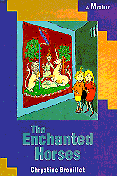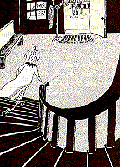


|
The Enchanted Horses.
Chrystine Brouillet. Illustrated by Nathalie Gagnon. Translated by Linda Gaboriau.
Grades 3 - 6 / Ages 8 - 11. * /4
|

excerpt:
Just then the announcer said there would be a delay in announcing the results of the race. The wait was awful. It seemed to go on forever. Then the announcer came back on the loudspeaker. Lightning III was the winner. "But he came in second " protested Arthur. "And . . ." before Arthur could finish his sentence they announced that Pegasus had been disqualified. The race officials had found that he'd run the race on drugs. "What!" yelped Eliza. "That's impossible!"
Andrea and Arthur are thrilled by the opportunity to visit former schoolmate Eliza at her home in the country. After their first hellos, they are anxious to get out to the riding stables. Their first ride is a short one as Eliza wants to be back home to greet her uncle Edward who was arriving that day from France with his race horse, Pegasus. Things begin to go very wrong when Pegasus runs his first race and subsequently tests positive for drugs. Although the children want to help, they are encouraged by Eliza's mother to attend a party hosted by the new owner of the mansion near Four Oaks corner. Mr. Lemnir talks about his plans for his stables and immediately gains Eliza's interest. What intrigues Arthur and Andrea is an ornate divinatory plate which is locked up in the mansion library. As reporter and photographer for the school newsletter, "The Sherlock," Arthur and Andrea are keen detectives and want to try the divinatory plate to help them discover who drugged Pegasus. Mr. Lemnir agrees only to forecast Eliza's future. He predicts her success as an Olympic champion riding her beloved horse, Mercury. Eliza's plans are shattered when she discovers that Mercury has been stolen during the night. Mr Lemnir has a magical solution for the recovery of Mercury, but his skills at deceipt are not equal to the detective skills of Andrea and Arthur.

Chrystine Brouillet is the experienced author of novels for children and adults. Her publications with La Courte Echelle include numerous mysteries in the Roman Jeunesse series. Her readers are enthusiastic about her work, and have twice voted her their Favourite Author with the Signet d'or Award. The Enchanted Horses, a translation of Les chevaux enchantes, originally published in l994, will not win as enthusiastic a readership in the English translation. As the narrator, Andrea never comes into clear focus. She intersperses her storytelling of the mystery plot with glimpses of her home life and her feelings, but these are apparently thrown in at random and are never explored. What we learn of Arthur and Eliza is again, sketchy, and neither child takes on a distinctive voice of his/her own.
The plot has many components which should attract young readers: horses, a mansion, a magical element and independence. In this case, less would have been more, as the extra problems, ranging from the drugging and theft of Pegasus to the intentional hit-and-run which leaves Edward injured, overload the storyline. The female police officer, a feature of Brouillet's plots, is very competent and forthright with the children, but, again, she is introduced late in the story and serves more to provide a cautionary component than as a strong character. The mix of the alchemy/supernatural element with the mystery might have had more success had Lemnir been a more credible character. His menace was apparent from the start, but he appears primarily as a figure of ridicule. He is dismissed in a much too hasty conclusion which also telescopes a considerably complicated plot into four or five paragraphs.
The partnership between Brouillet and Nathalie Gagnon with La Courte Echelle is a long-standing one. Gagnon is a distinctive illustrator for Brouillet and is associated with many of the Roman Jeunesse series. Gagnon's pen and ink drawings abound in the book, creating quirky, fun characters in hand-drawn borders, which fade in and out around the scenes. The drawings are an enhancement within the text, but are not served well by the coloured cover design which diminishes their effectiveness. The book cover is not attractive and will not sell itself on paperback racks.
Linda Gaboriau is an experienced translator of texts for Brouillet and for Ragweed Press as a publisher. In this case, some of the flatness of the prose may be a result of the difficulties of the text itself, rather than the translation.
The Enchanted Horses may gain a readership among junior fiction readers based on the melange of mystery, magic, and horses; however, the flat style, complicated and uneven plot, and thin characterization may discourage its intended audience.
Recommended with reservations.
Jennifer Johnson works as a librarian in Ottawa, Ontario.

To comment on this title or this review, send mail to cm@umanitoba.ca.
Copyright © 1997 the Manitoba Library Association. Reproduction for personal use is permitted only if this copyright notice is maintained. Any other reproduction is prohibited without permission.
Published by
The Manitoba Library Association
ISSN 1201-9364
TABLE OF CONTENTS FOR THIS ISSUE
AUTHORS | TITLES | MEDIA REVIEWS | BOOKSHELF | BACK ISSUES | SEARCH | HOME